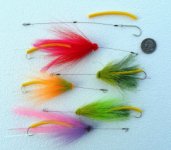F
Fishidiot
Active member
- Joined
- Sep 9, 2006
- Messages
- 9,960
Flies for toothy critters that require wire construction have had me experimenting for years. While I haven't been able to get to the beach and chase bluefish as much as I'd like this year, I did throw together some bluefish flies recently. Blues, esp big choppers (fish over several lbs) respond well to large flies with bulk and bright colors. Due to their strong jaws and tendency to seize flies or lures mid body.....a single, barbless hook at the rear of the fly or lure works best IMO. Stay away from trebles with blues as they're very tough to unhook. Anyway, here's my current concept for bluefish flies. It utilizes 30-40# wire and three crimps. Note the split ring at the front of the bite leader - this allows a better knot connection and prevents the wire itself (which can be rough) from cutting the mono. I do this now with all my wire leader flies. For smaller blues of the summertime variety, just scale this fly down in size to about a 3" fly body size. For the bigger guys I like a fly with a 4-6" body length
STEP 1:
Crimp the hook - you'll want about 5-8" total length depending on fly size and how much length you want for the bite tippet. I like a single, sturdy, barbless hook that is honed needle sharp. At the top of the pic you can see the set-up before the tube is installed.
STEP 2:
Slip the rubber sleeve on to the leader. For this application, I use 1/8th inch rubber tubing. The tube protects the hook crimp a bit and keeps the hook from flopping around and snagging the fly during casting. It also provides some additional color and protection from teeth and pliers as well as keeping the fly in a fairly straight form.
STEP 3:
Put a crimp (or two) at mid leader where the approximate head of the fly will be tied, then crimp the split ring eye.
STEP 4:
Place the set-up in your vise by clamping the vise jaws over the crimp itself - this is tricky and is why having two crimps can make things easier. You will then start your thread head over this crimp and build it up enough that you have a base to tie the rest of the fly. By tying the head over a crimp this way, you can prevent the problem of the fly sliding up and down the wire. I like deer hair with lots of flash and a small, clipped head.
There are, of course, many ways to approach this style of fly. Experiment with what works best for you.
STEP 1:
Crimp the hook - you'll want about 5-8" total length depending on fly size and how much length you want for the bite tippet. I like a single, sturdy, barbless hook that is honed needle sharp. At the top of the pic you can see the set-up before the tube is installed.
STEP 2:
Slip the rubber sleeve on to the leader. For this application, I use 1/8th inch rubber tubing. The tube protects the hook crimp a bit and keeps the hook from flopping around and snagging the fly during casting. It also provides some additional color and protection from teeth and pliers as well as keeping the fly in a fairly straight form.
STEP 3:
Put a crimp (or two) at mid leader where the approximate head of the fly will be tied, then crimp the split ring eye.
STEP 4:
Place the set-up in your vise by clamping the vise jaws over the crimp itself - this is tricky and is why having two crimps can make things easier. You will then start your thread head over this crimp and build it up enough that you have a base to tie the rest of the fly. By tying the head over a crimp this way, you can prevent the problem of the fly sliding up and down the wire. I like deer hair with lots of flash and a small, clipped head.
There are, of course, many ways to approach this style of fly. Experiment with what works best for you.




